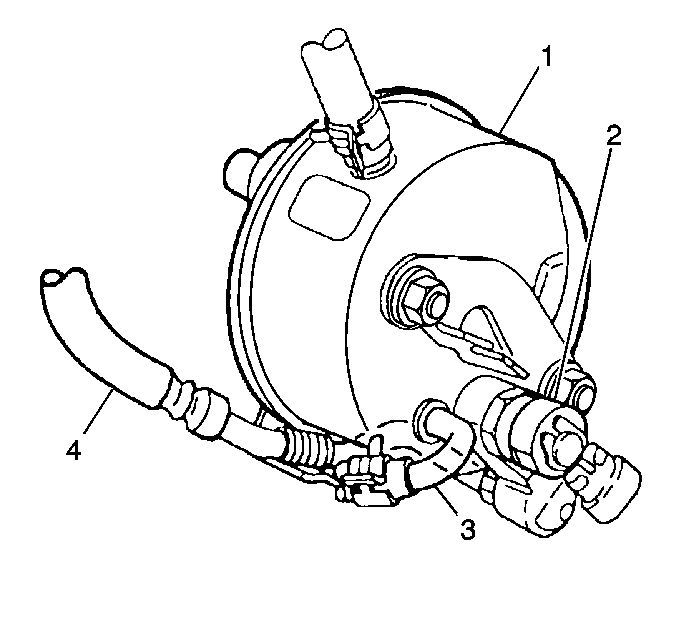Tools Required
| • | J 5176-E Power
Steering Pressure Tester |
The power steering system test is a method used to identify and isolate
hydraulic system difficulties. Prior to performing this test, inspect the
following components and make any necessary corrections:
| • | The condition of the pump drive pulley. |
Important: Perform all the tests with the engine idling at the normal operating
temperature.
- Turn OFF the engine.
- Place a container under the power steering system in order to
catch the power steering fluid before disconnecting the power steering hoses.

- Disconnect the pressure hose (4) at the power steering pump (1) or at
the hydraulic booster. Refer to
Power Steering Hoses Replacement
.

- Install the J 5176-E
between the pump (1) and the hydraulic
booster.
Ensure that the gauge is between the shutoff valve and the pump (1).
- Open the shutoff valve.
- Remove the filler cap from the pump reservoir.
Check the fluid level.
- Fill the pump reservoir with power steering fluid to the FULL/HOT
mark on the dipstick.
- Start the engine.
- While momentarily holding the steering wheel against the stop,
check the connections at the J 5176-E
for leaks.
- Bleed the power steering system. Refer to
Power Steering System Bleeding
.
- Insert the J 5421-02
in the reservoir filler opening.
Important: Do not turn the steering wheel more than five times without rolling
the vehicle in order to change the tire-to-floor contact area. Failure to
follow this precaution may result in flat spots on the tires.
- Move the steering wheel from stop to stop several times until the J 5421-02
indicates that the hydraulic
fluid in the reservoir has reached a temperature of 65-77°C (150-170°F).
- Check the power steering pump fluid level. Add power steering
fluid, if necessary.
- Read the J 5176-E
.
| • | The initial pressure reading on the J 5176-E
, with the shutoff valve open, should not exceed 1034 kPa
(150 psi). |
| • | Readings exceeding 1034 kPa (150 psi) indicate a
restriction in the system. |
| • | If the reading is high, turn OFF the engine immediately. Locate and
repair the restriction. |
Notice: Do not leave the valve fully closed for more than 5 seconds, or the
pump could be damaged internally.
- Open and close the J 5176-E
gauge valve fully 3 times.
- Record the highest pressures attained each time:
| • | If the highest pressures are within the range of 9308-9998 kPa
(1350-1450 psi) and within 345 kPa (50 psi) of
each other, the system is functioning normally. |
| • | If the pressures recorded are within the range of 9308-9998 kPa
(1350-1450 psi), but not within 345 kPa (50 psi)
of each other, perform the following procedure: |
| 1. | Remove and clean the power steering pump flow control valve. |
| 2. | Remove any burrs using crocus cloth or a fine hone. |
| 3. | Flush the system if it is contaminated. |
If the power steering system is exceptionally dirty, completely disassemble,
clean, flush, and reassemble the pump and the gear prior to further use. Also
flush the reservoir.
| • | If the 3 pressure readings are within 345 kPa (50 psi)
of each other, but are not within 9308-9998 kPa (1350-1450 psi),
perform the following procedure: |
| 1. | Replace the flow control valve and recheck the pressure. |
| 2. | If the system fails the test a second time, replace the rotating
group and recheck the system. |
| • | If the pressures are within specifications, perform the following
procedure: |
| 1. | Ensure that the valve is open. |
| 2. | Turn the steering wheel to both stops. |
| 3. | Record the highest pressures and compare with the maximum pump
pressure recorded. |
| 4. | If the maximum pump pressure cannot be reached in at least one
side of the gear, the gear is leaking internally. |
| 5. | Disassemble and repair the gear. |
- Turn the engine OFF.
- Remove the J 5176-E
.
- Reconnect the pressure hose (4). Refer to
Power Steering Hoses Replacement
.
- Bleed the system. Refer to
Power Steering System Bleeding
.
- Check the fluid level and/or make the necessary repairs. Refer
to
Checking and Adding Power Steering Fluid
.
- Examine the steering and the front suspension thoroughly if the
problem still exists. Refer to
Steering Linkage Inspection
in Steering Linkage (Non-Rack & Pinion).


